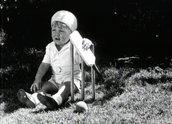

That’s Cricket (c.1931)
Synopsis
This featurette was directed by Ken G Hall for Australasian Films and made with the cooperation of seven members of the successful Australian XI cricket team, including Sir Donald Bradman, who toured England in 1930. It promotes cricket and its importance to the British Empire and Australian identity. The film includes footage from a 1905 British Pathe Gazette newsreel and a 1921 cricket tour, and highlights the sporting skill of some of the 1930s test players. Don Bradman and team captain Bill Woodfull address the audience throughout the film.
Curator’s notes
Under the guidance of Australasian Films’s managing director, Stuart Doyle, Ken G Hall directed this featurette for Union Theatres about the game that, according to the closing narration, 'helps unite the Empire’. Cricket’s popularity was buoyed by the recent success of Don Bradman, one of the all-time greats of the game, and the young Hall wanted to record as many of the current cricketing champions on sound film as possible. Hall had been on staff since he was 17 – starting out in the publicity department – but this was his first major work as director for the company. He scripted the film’s narration as well as Bradman’s and Woodfull’s pieces to camera. Riding on the popularity of cricket with the populace, as well as the relatively new medium of sound film, That’s Cricket was a success with audiences at Sydney’s Prince Edward Theatre and around Australia.
The film makes explicit the importance of the game within the British Empire (of which Australia was a part). Britain – and by extension Australia, another 'civilised’ nation which played the 'gentlemen’s game’ – was spreading cricket to countries like Ceylon and India. At the height of the British presence in India (today, one of the world’s great cricketing nations), cricket is linked with colonialism. As a game common to all nations throughout the British Empire, cricket helps 'unite the Empire’ and plays an important part in 'civilising’ the peoples of the subcontinent.
Many of the players in this film can be seen in a more relaxed and informal mode in home movie footage taken by team manager WL Kelly during the 1930 tour to England (see Henshall, Mr: Australian Cricketers Visit Ceylon, Naples, Switzerland and Practise at Lords).
- Overview
- Curator’s notes
- Video 2 clips

- Principal credits
- Find a copy
- Make a comment
- Add your review



